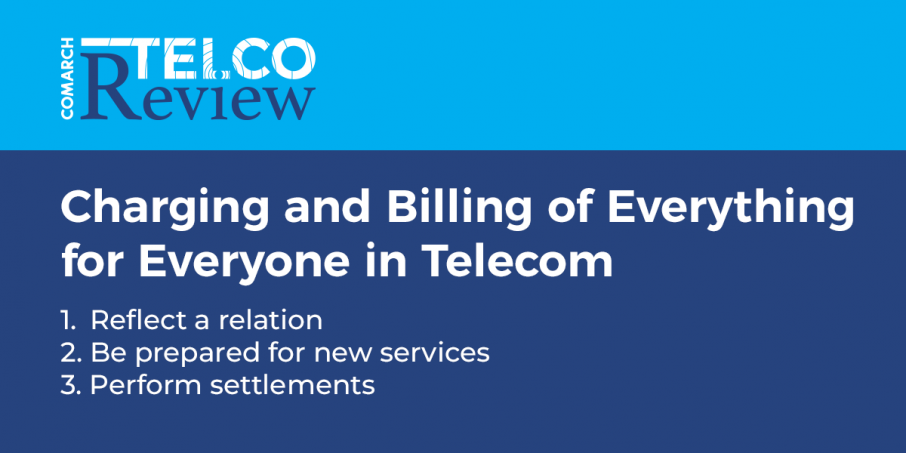Charging and Billing of Everything for Everyone in Telecom: Three Key Areas to be Addressed
- Published
- 6 min reading

Let’s get an insight into the world of billing and charging in telecom. The presence of many diverse event-based OTT billing players means either competition or an opportunity for cooperation for telecommunications operators who want to stay in the market. The potential battle will take place on two fronts – attracting new customers and satisfying existing ones.
Charging and billing in telecom from the customer’s perspective
As it is vital in both cases to be ready for all novelties on the market, and even to anticipate them, it seems that cooperation with partners is the better choice; it allows operators to offer customers various own-branded services, to compete more vigorously with other operators, to create service bundles, and to attract customers by giving them something for free or for a trial period. Unfortunately, the complexity of cooperation with partners and the uniqueness of services have an impact on IT systems, which must be capable of helping operators create relationships with business partners, cooperate with them, and perform settlements.
On the other hand, there is always an end customer, and any type of service provided by partners must be offered in an attractive form, self-service channels should be presented and operate in the same way across the board, and a single bill for all services should be provided for each service period. The potential variety of services which could be offered to end customers, and the complex models of cooperation between partners, mean that billing and charging in telecom operations, of everything for everyone, is a must for an operator.

The difference between charging and billing in telecom and how to take advantage of them
The three points presented below summarize the conditions that such a system must meet:
Reflect a relation
The whole process of negotiations and agreement conditions are stored in CRM systems, however charging and billing must be ready to store some data related to calculating and raising bills.
Cooperation rules can have an impact on how the revenue from the end customer will be shared between the operator and partners. As it is possible to have more than one partner in a chain, complex revenue sharing models have to be addressed. Moreover, the terms of any agreement with a business partner can influence the price for the end customer, so the flow of money must be fully traceable.
When considering settlements with partners and selling services to end customers, we can differentiate models such as sell of, sell to, sell through or sell with. Depending on the model, services provided by a partner are sold directly to the end customer by them or by an operator, through a partner, or only by an operator. In addition, the model selected will have an impact on the behavior of the system, and various financial documents must be generated.
Be prepared for new services
IoT, M2M, cloud-based services, rich media, eHealth… these are just some of the new services, on top of voice, data an SMS, which are appearing more and more often in operators’ offers. For customers, it is very important to have one agreement with one operator, and to have all services charged to one bill. However, from the IT ecosystem perspective, this is easier said than done; the operator must be ready for the creation of bundles, taking into account everything they would like to sell, and above all they must have the capacity to do this very quickly.
Another aspect is support for new models for price calculation of charging in telecom, such as telecom OTT subscription management, based not only on usage, events or subscriptions but also on, for example, billing depending on application, device/machine use and SLA/QoS agreements. In addition, information about customer usage is required as soon as possible via online services, and there must be a means of notifying customers about defined thresholds.
Perform settlements
When considering billing in telecom, B2X, B2B2X or even B2X…2X models for settlements must be supported in order to provide appropriate financial documents to everyone involved in the chain of providing a service to a customer. In some cases, it is also the operator’s responsibility to create outpayment documents, because they have to pay a partner for service provided.
Let’s consider an example telco operator, which would like to add a Connected Car service to their standard offer. The service includes an in-car device, and specialized applications such as parking assistance or intelligent car analytics. In order to do provide such a service, our telco operator has to sign an agreement with a device manufacturer and an application provider. Based on agreements with these partners, various charges will be calculated. In the case of the device manufacturer, the operator may pay for devices, while they will pay the application provider per application downloaded by the end customer. So in fact we have two different models for calculations.
At the end of the chain is the customer, who purchases the Connected Car service and will pay the telco operator for this. The money received by the operator will be divided into three parts, between themselves, the device manufacturer and the application provider. In fact, there are four entities involved in this example, so an invoice must be created for the end customer, along with two further documents based on which our telco operator will share revenue with partners.
And, because cooperation is not limited only to one country, aspects such as multi-currency and multi-language must be addressed. The final important element regarding settlements is the system’s ability to create one single invoice for the end customer, no matter what type of a service they purchased.







